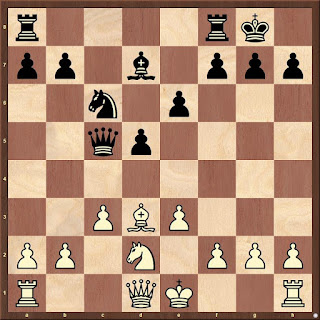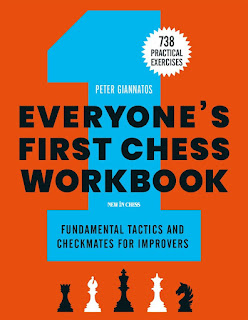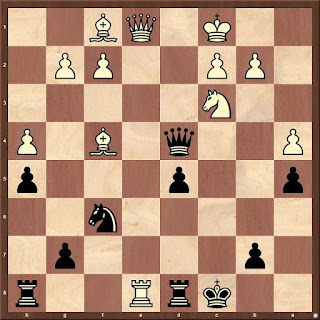BOOK REVIEW by Carl Portman
THE MAGNUS METHOD
The singular skills of
the world’s strongest chess player uncovered and explained
by Emmanuel Neiman
Pages: 320
Published by: New In Chess
2021 Softcover
What is this book about?
The
official synopsis:
What
is it that makes Magnus Carlsen the strongest chess player in the world? Why do
Carlsen’s opponents, the best players around, fail to see his moves coming?
Moves that, when you replay his games, look natural and self-evident?
Emmanuel
Neiman has been studying Carlsen’s games and style of play for many years. His
findings will surprise, delight and educate every player, regardless of their
level. He explains a key element in the World Champion’s play: instead of the
‘absolute’ best move he often plays the move that is likely to give him the
better chances.
Carlsen’s
singular ability to win positions that are equal or only very slightly
favourable comes down to this: he doesn’t let his opponents get what they hope
for while offering them the maximum number of chances to go wrong. In areas
such as pawn play, piece play, exchanges as a positional weapon and
breaking the rules in endgames, Neiman shows that Magnus Carlsen has brought a
new understanding to the game.
Neiman
also looks at Carlsen’s key qualities that are not directly related to
technique. Such as his unparalleled fighting spirit and his ability to
objectively evaluate any kind of position and situation. Carlsen is extremely
widely read and knows basically everything about chess. What’s more, as the
most versatile player in the history of the game he is totally unpredictable.
The
Magnus Method presents a complete analysis of the skills that make the
difference. With lots of surprising and instructive examples and quizzes.
Examining Carlsen’s abilities together with Emmanuel Neiman is a delightful way
to unlock you own potential.
Contents
·
Foreword
– by Emanuel Neiman
·
Introduction
-
·
Thirteen
chapters
·
Index
of names
·
Bibliography
My thoughts and comments
This
book has a very interesting layout. The chapters are divided into a specific
approach by Carlsen to phases of the game, such as Calculation, planning,
Attack, Defence, pawns, Endings, tactics and exchanges to name some. Chapter 12
is entitled ‘How to win against Magnus Carlsen: The hidden defects?
Well
in one sense we are never going to need this, because we are never going to
play against Magnus Carlsen but I wonder how many of the top players might have
paused over this little chapter which is only four pages in length, two of
which are diagrams.
I
enjoy endgames, so I visited that section of the book and attempted to ‘be’
Magnus and solve some of the puzzles. There really were fun. So many ‘easy to
lose’ rook and pawn endgames. This gives an insight into how good Magnus really
is.
I
learned more about Magnus the chess player. I can see now how he does not mind
to give up a pawn – sometimes even two – for activity in his quest to find a
win. This occurs, where other players would be content with a draw.
He
is excellent at finding ‘backward moves’ which is something that many chess
players struggle with. Let’s look at an example. In this position, what would
you play?
Be
honest, you never considered 7.Ng1 did you? The computer actually recommends
7.Nc1 which seems more logical to me. We don’t really learn why Magnus
played this, but it was a rapid Internet game so I am not going to get hung up
about it. I wonder if he would have done similarly in a Classical game.
We look at the author’s view about positives
and negatives and note that the strengths are not directly related to
technique. He notes Carlsen’s strong points which come under six headings, and
what about his ‘hidden defects?’ Well, this is covered in Chapter 12 but there
are only a couple of pages of prose, followed by 9 diagrams as examples. Not
much then in terms of defects, but then he is Magnus Carlsen. Perhaps his
greatest defect is his optimism, which can lead to greater risk-taking. Well, I
am sure that Ian Nepomniachtchi will be interested as he is soon to face MC in
the World Championship finals.
Chess games
There are plenty of games, but not
necessarily beginning from move one. We pick up positions part way through,
depending upon the theme and the moment of truth, so to speak. The ‘games and
solutions’ section takes up over half of the book and I suppose if the reader
was lazy, they could turn directly there and enjoy the feast of fun in the
answers but really this needs to be looked at as a whole and requires patience
and time. A disciplined approach to study will reap rewards.
Does the book achieve its aim?
The author asks at the very beginning ‘Why
another book on Magnus Carlsen?’ Well, this is different because of the layout
of the book and it does zero in on fundamental aspects of his game in a clear
and concise way. I have to say, the introduction is a long 21 pages but it does
lay the foundation for what is to follow.
My chief question was ‘Can a club player
really try to be Magnus in these puzzles?’ The answer is a resounding yes. Have
a go, try to get into his head. I was surprised how many successful attempts I
made. Whilst the aim of the book is of course to examine MC in all his glory we
should not forget that by doing so, the club player should be able to raise
their own level of chess understanding and subsequently their own playing
strength.
Magnus says that he wants every chess game
to be an event. This book is an event in itself and one could spend many hours
over this coming winter enjoying the fruits of the author’s labour.
Just to note that the paper quality and
text are excellent, as always with NIC. The diagrams are plentiful but I would like them to be a
little bigger. I appreciate that this would increase the size of the book and may
lead to increased cost to the consumer.
I wonder what Magnus would make of this
book? Personally, I enjoyed it and I intend to spend more time studying it.
Who is the author?
Emmanuel
Neiman is a FIDE Master who teaches chess in his home country France. He is the
(co-) author of Invisible Chess Moves and Tune Your Chess Tactics Antenna,
highly successful books on tactics and training.
Praise
for Emmanuel Neiman:
“An enjoyable and challenging book that will make you
redress your competitive play.” Yasser
Seirawan, four-time US Champion, on ‘Invisible Chess Moves’












